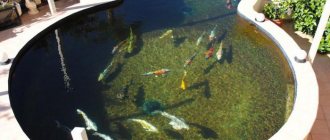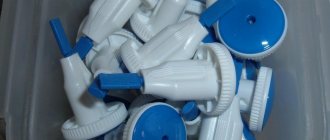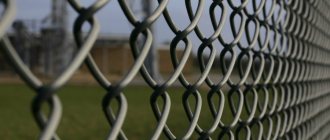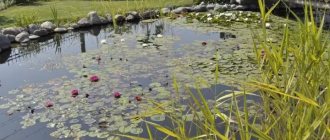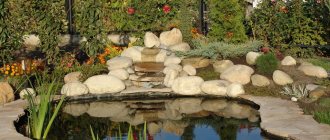- Sorption purification
- Bioplato
Without proper care, any artificial reservoir loses its attractiveness over time: the water becomes cloudy, the surface is overgrown with duckweed, the bottom is covered with silt, mud and an unpleasant odor appear. How to clean a pond at your dacha with your own hands and properly maintain it in perfect condition will be discussed in detail in the article.
An artificial pond serves as an excellent decoration for landscape design even in small areas, but requires constant maintenance
A garden pond is a non-flowing artificial structure in which over time a natural ecosystem (biocenosis) is formed, consisting of aquatic plants, living creatures and microorganisms. Ideally, the biocenosis should maintain its own balance, but, unfortunately, the smaller the body of water, the less stable its ecosystem . The composition of the water in a small pond changes too often and sharply due to temperature fluctuations, the ingress of plant debris and animal waste products, increased evaporation and loss of oxygen.
Changes in the composition of water create favorable conditions for the accelerated development of some plants and microorganisms to the detriment of other inhabitants of the reservoir. As a result, the pond begins to “overgrow” and “silt up,” quickly becoming shallow and turning into a swamp.
To maintain the attractive appearance of a landscape object, owners are forced to regularly intervene in the functioning of the ecosystem and correct negative changes.
Radical cleaning of a country pond is carried out with complete drainage of water. This is a difficult and very labor-intensive undertaking, in which, in addition, loss of aquatic life and vegetation cannot be ruled out. With proper regular care, a medium-sized pond (up to 5 m2) needs to be radically cleaned no more than once every 3-4 years (some owners, by properly “populating” the pond, manage to preserve the natural ecosystem for 10 years or more with minimal intervention).
Rules for regular care
Constant care is the key to the attractiveness of an artificial pond or lake over a long period of time.
The frequency of cleaning activities depends on the size of the artificial reservoir, its location, weather and climatic conditions and other factors
We suggest you take note of the following rules:
- Install a forced circulation water filter with gravel or sand media. It will get rid of small debris and saturate the water with oxygen. During the warm season, the device should operate around the clock.
- Equip your pond with stone or concrete edges (the height of the fence should be at least 30 cm above the ground and 10 cm deep) to prevent earthworms from getting into it after heavy rains. They die in the water, and their remains decompose, causing harm to the permanent inhabitants of the reservoir.
- Remove large floating debris daily with a net or net. It is stretched across the entire surface of the pond, submerged using weights, and then stretched along the surface of the water, collecting debris.
- Remove debris that accumulates at the bottom using a regular net. A vacuum cleaner will help make this daily work much easier.
- The surface of the water in a garden pond should not be exposed to bright sun all day, preferably no more than 5-6 hours a day. To avoid increased evaporation of liquid and loss of oxygen, which will inevitably lead to waterlogging, the dacha pond is specially shaded by planting low ornamental shrubs along the banks. If the pond is located in an open area, in hot weather it is covered for several hours a day with material that does not allow sunlight to pass through.
- On hot days, the water level drops quickly due to evaporation. Regularly add the required amount of fluid. This will ensure a constant salt balance, which is important for the proper growth and development of plants.
Biological purification
This option involves restoring the biological balance of the water body. Ponds are cleaned by using a special device that produces beneficial microorganisms that activate the self-purification of a pond, river or lake. The so-called “self-disinfection” effect is triggered: the acidic regime is balanced, bottom sediments are cleared of organic elements, and protozoan algae die off. The advantage of the biological method is complete safety for the environment.
Effective cleaning methods
Methods for clearing contaminants from a country pond can be divided into groups:
- mechanical;
- chemical;
- biological;
- physical (using ultraviolet radiation).
Which option to choose depends on the degree of contamination of the pond, its size, the presence of ornamental plants and other individual parameters.
Mechanical
These are the simplest and most common cleaning methods used by owners of artificial lakes.
A regular plastic net is convenient for collecting debris floating on the surface of the water.
Debris is removed manually or using special devices and equipment. Of course, it’s easy to remove leaves, grass and branches floating on the surface with your hands, a net or a net, and wipe off the greenery from the walls and shallow areas of the bottom with a brush, but these are only “cosmetic” measures. To prevent stagnation and pollution of water, it is necessary to ensure its movement, that is, circulation. To do this, use aerators (surface: floating, fountain, injection or shore/bottom compressors) and various filters .
A set of filtration and aeration systems is provided at the design stage of an artificial reservoir.
Filtration equipment
Most often, owners of private ponds install pressure or flow filters, which differ in their operating principle:
| Type | Operating principle | Advantages |
| Pressure | A pump located at the bottom pumps water under pressure into the filter tank, where brushes and sponges first trap dirt and plant debris (mechanical cleaning). Then, passing through a filler made of mineral biogranules, the water is biologically purified. The built-in ultraviolet sterilizer lamp ensures the destruction of harmful microorganisms. Purified water is also supplied back under pressure | Simplicity of the device, compact size, ease of use. Suitable for ponds with slides, steps and streams, as it can supply purified water to a height of up to 2 m. Three-stage filtration system |
| Flow-through (external) | Installed on the shore (above the water level). Water is supplied to the filter using a pump, and after cleaning it returns by gravity | High productivity, long service life. Carries out mechanical, biological and ultraviolet (if a UV sterilizer is available) cleaning of large reservoirs |
To maintain cleanliness on the surface of the pond, skimmer to suck in water and collect all debris in their basket. Depending on their location, they can be bottom, shore (built-in) or floating.
A robot vacuum cleaner and other professional equipment are more likely to be needed by pool cleaners.
In order to regularly get rid of dirt, algae and silt deposits at the bottom, some summer residents, who are not too limited in financial resources, purchase special vacuum cleaners - “silt cleaners” with manual or automatic control. Hand-held devices are well suited for desilting small and medium-sized ponds that have a non-standard shape and a textured bottom. They come with various functional attachments and a garbage bag.
It is undesirable to use such devices in bodies of water where fish or frogs live, since the cleaning process destroys fry and tadpoles.
For practical tips on how to tidy up and improve an old pond at your dacha, watch the video:
If there are filtration systems, the use of skimmers and suction pumps, the owner’s work is reduced to timely maintenance of the equipment: replacing cartridges (depending on the model), washing filters and cleaning waste collection tanks.
Chemical
Chemicals are practically not used in cleaning artificial reservoirs inhabited by plants and living inhabitants. Aggressive preparations based on chlorine compounds, of course, will help to quickly clear the pond of algae (including beneficial ones), without affecting the acid balance of the water. However, they will significantly reduce the content of active oxygen, which is necessary for the respiration of fish and other living creatures, and the decomposition of ballast and harmful substances (waste products and toxic nitrogen compounds) by aerobic bacteria. Preparations containing bromine are considered the safest, but their use without chlorine reagents is ineffective.
Sorption purification
An acceptable chemical method is sorption purification using porous minerals - zeolites of natural or synthetic origin, which can be used to remove phosphorus and ammonium from water. Sorbents are placed in chambers of flow filters or simply scattered along the bottom at the rate of 0.5-1 kg per volume of 1000 liters for 1 year.
Liming
To speed up the decomposition of organic contaminants, increase the oxygen content in water, and disinfect it from harmful bacteria and parasites, slaked or quicklime and ground limestone are used.
If fish live in a pond, then a large amount of organic matter accumulates in it (waste products, food residues, zoo- and phytoplankton, dead plants)
The choice and dosage of the product depend on the method of application (by water or on a dry bed), the composition of bottom sediments, and the pH level of water and soil. For disinfection of a household pond, it is considered optimal to add quicklime in the amount of: 1 kg/10 m2 - on water, 0.5 kg/10 m2 - on a dry bed. Preventive liming with water is usually carried out in May - the first half of June at intervals of every two weeks, at the rate of 0.1 kg/10 m2.
Slaked lime and ground limestone are taken 1.3 or 1.8 times more, respectively.
Biological
For biological purification of ponds on personal plots, the following is used:
- bacterial preparations such as JBL FilterStart Pond, Starter-Bacterien, etc., which are added to the filter substrate. They begin to act instantly, decompose bottom silt, destroy harmful nitrogen compounds;
- products Algenkiller, Aqua Balance, “Prudochist”, etc. Cause the death of microscopic green algae, inhibiting the process of photosynthesis. Available in powder or liquid form. You can scatter it over the surface of the water or simply pour it into a pond. Validity period is about 6 weeks.
Advantages of biological products : speed of action, effectiveness, safety (provided you follow the instructions). Disadvantages : relatively expensive, changes in the composition of water, which requires the parallel use of drugs that reduce the concentration of methane and hydrogen sulfide, regulate pH and enrich water with oxygen, or aeration with special devices, which further increases the cost of treatment.
Installing high-quality filtration systems allows you to keep the pond clean for a long time
Bioplato
One of the safest and most effective ways to constantly clean a garden pond is the construction of a bioplate or pond . In essence, this is an artificial shallow that acts as a filter. As a rule, a pond (one or several) is placed next to the main reservoir, but slightly above its level (by a step), so that the water supplied by the pump to the bioplate slowly flows through it into the main pond. The depth of the pond does not exceed 50 cm. Its bottom is lined with a thick (up to 150 mm) layer of drainage material (for example, gravel, coarse sand, etc.), and planted with plants whose roots aerate the water well and prevent the bottom from compacting.
The bioplato ensures constant circulation and filtration of water, its saturation with oxygen
UV
Devices that act as sterilizers and prevent the activation of tiny algae and other harmful microorganisms are ultraviolet lamps that can be immersed in water . The UV method is simple, effective and safe for water inhabitants. It is popular with owners of small ponds. However, it should be noted that ultraviolet irradiation does not help clean the reservoir from large debris and bottom sediments, so the method should be used in parallel with the others listed above.
Use of chemical reagents
Another method of removing contaminants from water bodies using special preparations. Only in this case, chemicals are used that perform three functions: normalizing acidity, increasing oxygen levels, and dissolving algae. Over time, the reagents break down into water and carbon dioxide, which helps reduce sludge volumes. The chemical procedure can be carried out in two ways: adding measured portions of chemicals manually or installing an automatic system at the bottom.
Changing water
If a set of cleaning measures no longer helps to restore the pond to its original appearance, a radical method remains - a complete replacement of water.
To thoroughly clean an open pond, it needs to be completely drained from time to time.
When getting started, stick to the following plan :
- If there are fish, frogs or other specially inhabited inhabitants, catch them and transplant them into a separate container.
- If possible, remove ornamental plants.
- Drain all the water.
- Clean the bottom and all internal surfaces of silt and other debris.
- Fill the pond with water and return the plants to their original places.
Fresh water after a complete change can quickly become cloudy. You should not be afraid of this - this is how the work of microorganisms manifests itself, which quickly multiply in a clean reservoir. After a couple of days, the water will clear itself, and after another week, when the biobalance is restored, it will be possible to return fish, snails and other inhabitants to the pond.
Ultraviolet treatment
An effective modern method is to clean ponds using an ultraviolet filter. It allows you to quickly get rid of bacteria, viruses and algae. Ultraviolet light destroys the DNA of microorganisms, thereby “killing” them. This is facilitated by an ultraviolet lamp located inside the filter. All that is needed to clean the object is to install the device correctly and protect it from overgrowing. It is also recommended to change the lamp every season so that the intensity of UV radiation does not decrease.
If you don’t want to one day see an unsightly puddle instead of your pond or river, be sure to use one of the methods described above for caring for reservoirs. Moreover, nowadays they are absolutely accessible to everyone.
Severe siltation of the riverbed and sometimes excessive cluttering of the bottom can significantly affect the quality of water, the health of aquatic inhabitants and the aesthetic appearance of the reservoir. The process of decay in water stimulates the development of unicellular algae and, accordingly, cloudiness of the water. All this prevents the penetration of sunlight, creating favorable conditions for waterlogging of the reservoir, overgrowing with algae and reeds. This can be prevented by clearing the reservoir of silt. There are several ways to do this:
Traditional methods of keeping the reservoir clean
To create a natural ecosystem and constantly maintain a garden pond in good condition, experienced summer residents plant the bottom and coastal zone of the pond with plants such as nymphea, elodea, fontinalis, arrowhead, calamus, hornwort, marsh iris, cattail, and reed. In most cases, these are not purchased seedlings at all, but specimens dug up near the nearest river or swamp.
Plants taken from natural reservoirs perfectly fulfill their role in the newly organized biocenosis, without getting sick or suffering from changes in living conditions
Planting material (rhizomes) is often planted in ceramic pots, which are placed on the bottom. As winter approaches, the pots are moved deeper so that the plants do not die even if the pond freezes completely.
To maintain the natural ecosystem of , some summer residents also advise:
- populate reservoirs with small river fish (for example, crucian carp), snails or freshwater crustaceans (daphnia);
- keep mesh containers filled with sphagnum moss or peat tablets in water;
- periodically lower a bunch of fresh willow twigs, cleared of leaves, into the pond.
Correct selection of pond flora and fauna will allow you to carry out complete water changes less frequently
A well-organized garden pond does not require frequent, labor-intensive cleaning and does not require the use of expensive equipment and consumables.
Operating principle
By giving preference to biological products for cleaning a pond from blooms, everyone makes a choice not only in favor of an effective, but also an environmentally friendly product. They increase the effectiveness of routine cleaning and do not have a negative impact on the inhabitants of the reservoir. The bacteria that are part of these drugs eat harmful microorganisms, thereby cleaning the pond.
The essence of the work of biological products is that the bacteria present in its composition enter the water, beginning to actively multiply and absorb debris that settles on the walls. Thus, these beneficial microorganisms become part of the pond's ecosystem and act as natural cleaners, preventing the occurrence of unpleasant odors and algal blooms in the water.
What is duckweed in a pond
The well-known dense carpet of a pond called “duckweed” is nothing more than small floating plants formed from leafy stems connected to each other. A single thread-like root emerges from them. At the base of the leaf there is a side pocket with a tiny inflorescence developing in it.
In the wild, duckweed blooms in open waters are observed extremely rarely, mainly in summer. Vegetation reproduces vegetatively (with the help of young leaves separating from the mother plant). Before the start of the winter season, the buds sink to the bottom along with the dead part of the duckweed, and with the arrival of the new season they begin to actively grow again.
Find out how to create a pond with the ability to swim in it.
- Among the main reasons that provoke the growth of duckweed, the following reasons always come to the fore:
- disruption of the ecology of the pond (relevant for industrial regions where residual products from various industries can be discharged into the water);
- excessive illumination of the reservoir for most of the day (these are almost ideal conditions for the development of duckweed);
- Consistently hot weather throughout the summer season;
- excessive heating of water in small areas of the pond;
- frequent visits to the pond by ducks (migratory birds often carry spores of various plants on their legs);
- stagnation of water, although the possibility of duckweed formation in rivers with high flow speed cannot be ruled out.
- This plant often disrupts the decorative appearance of a reservoir and prevents swimming and fishing in it, but at the same time, it also performs several positive functions:
- supplies water bodies with oxygen and cleanses them of carbon dioxide;
- protects fish from direct sunlight;
- often becomes good food for underwater inhabitants, and after catching the leaves - for waterfowl ducks or geese.
Read how to create an artificial pond for geese and ducks with your own hands.
Duckweed grows at lightning speed, but getting it out of the pond is not as easy as you might think at first glance, so keep an eye on what exactly you are planting in the pond and whether parts of the duckweed have stuck to the useful crop.
How to clean using chemicals
There are a huge variety of products on the market for cleaning muddy ponds. They are quite effective:
- dissolve excess vegetation;
- destroy bacteria and other harmful microorganisms;
- neutralize toxic compounds;
- restore normal acidity and other parameters.
But to use chemical compounds, it is necessary to remove all fish and other living creatures. Also, if the means are selected and used incorrectly, there is a high risk of causing irreparable harm to the ecosystem of the water area.
Ultraviolet radiation - who does it irradiate, why use it?
We must immediately dispel the myth about using UV lamps in aquariums and outdoor ponds - they do not affect fish, do not irradiate water with radioactive substances, and are absolutely safe, despite the fact that you have heard about their use more than once. There is no chemical impurity, there are no changes in the structure of the water. The basic principle of operation is the destruction of most bacteria and viruses by light. You can adjust the intensity of the glow, but even at its strongest setting, it barely kills single-celled green algae. The UV lamp serves as a disinfectant.
It is a completely sealed space through which water is passed under pressure. Over time, all the bacteria and microbes that infected the fish or algae will live for a long time. The UV lamp should be installed after the coarse filter, so that large particles do not get into it, and before the fine filter, so that bacteria or viruses do not settle. The water will be supplied there already disinfected, after which small particles of dead organic matter will be eliminated. The lamp is an additional means; it cannot be the main complex.
We have figured out how to clean a pond, now you can safely begin building (or directly fighting for a clean reservoir) a pond in your dacha. If you follow all the recommendations, the water will be mirror-like in just a few days, and will always remain that way!
When to clean
Several signs can be identified that indicate the need to take urgent measures to increase the transparency of the reservoir. This:
- the presence of a large amount of sediment at the bottom;
- inability to view the water area and see its inhabitants;
- the appearance on the surface of a so-called “film”, a dense “carpet” of mud and duckweed;
- the presence of an unpleasant odor.
If there are fish in the pond, a sharp decline in its population is a clear signal for urgent action.
If the water in the pond has become cloudy, you can act in several ways. Banal mechanical cleaning, the use of special equipment, and the addition of chemical and biologically active agents can make the pond transparent again. The choice of tools depends on the causes and degree of contamination of a natural or artificial reservoir.
